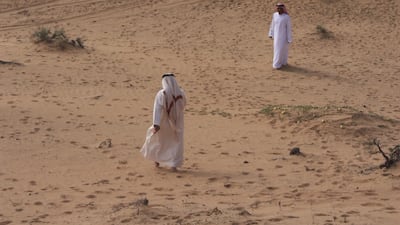February, 1943. The world is at war. And its unrelenting tragedy was about to be felt here in the UAE.
On February 1, a Royal Air Force plane took off from Sharjah headed for Jask, on the modern-day Iranian coast. Shortly into the flight, the port engine of the Bristol Blenheim Mark V failed and the pilot attempted a forced landing. But the aircraft overturned, killing three of the five onboard.
Local tribesmen helped the two who survived and the others were buried next to the crash site among rolling sand dunes, about 56 kilometres north-east of Sharjah.
The story had been lost for decades, buried in dusty archives and known only to the relatives and tribesmen living near the site who had named it "nad al tayyara," or dune of the plane. But the details have been unearthed by researchers here, using newly-digitised sources and an article published last year in Tribulus, the journal of the Emirates Natural History Group, has shed more light on the crash. Plane wreckage believed to be from the crash has also been found in the past few years.

Written by Ali Iqbal, Peter Hellyer and Laurence Garey, the article was the result of years of work.
Mr Iqbal learned about the crash while researching UK archives in 2015 about the impact of the war here. But a few years earlier and unbeknown to him, Emirati historian Dr Saif Al Bedwawi was contacted by a farmer in Sharjah who told him of plane wreckage found on his land. These pieces were brought to the Al Mahatta aviation museum in Sharjah, where the original RAF base was.
Mr Garey, independently from Mr Iqbal's research, was asked to help and he established it was from a Blenheim after consulting with aviation experts. Mr Iqbal then learned of the find and matched GPS coordinates of the plane's crash to the location of where the wreckage was found. It's now thought the debris is from the same plane.
The wreckage includes a Blenheim undercarriage frame, while serial numbers can be seen on some of the pieces. Metal fragments remaining at the crash site are believed to be from the plane. The three dead were pilot, sergeant Anthony Williams, flight sergeant and navigator William Hubbard and first lieutenant Alan Balzano Hailey, officer commanding the detachment of the RAF Levies in Sharjah and Dubai. His father was William Malcolm Hailey, a British peer who was governor of the Punjab from 1924 to 1928 and later in Africa produced the influential African Survey.
Their bodies have never been found despite extensive searches and appeals from relatives. The wreckage has now been painstakingly restored and plans are being formed to put it on display.
Hazelle Page is the collections manager for Sharjah Museums Authority.
"It's significant because we have a ... story that goes with it," she said. "With all objects, if they have a story, especially if you can relate it to a local place or local person is fantastic. And with all the documentation, it's really interesting."

The discovery of the 1943 crash again alters the perception that nothing happened here during the war. Other papers in Tribulus regarding more crashes reinforce this. The British air base at Sharjah may have been small but it was vital in resupplying Allied lines and countering Axis submarine activity in the Sea of Oman and Arabian Gulf. The Blenheim, also known as a Bisley and prone to breakdowns, was on a non-operational flight to Jask when it crashed but it also conducted these patrols.
Off the coast of Fujairah lies the wreck of Nazi U-boat 533, sunk by a depth charge from an RAF Blenheim in 1943, while an Italian submarine was sunk close to the Strait of Hormuz.

Crucial to the story is the help given to the two survivors by the Bedouins. The war had led to food shortages across the globe and the Trucial States was no different. Shipping lanes were disrupted, prices soared and the pearl trade, which had sustained generations, had collapsed.
“Life was very difficult during the Second World War, even though there was no direct fighting here,” said Dr Bedwawi. Despite this, Bedouin tribesman Mohammed bin Lahij took the two survivors to his tent where he and his wife gave them food, shelter and patched up their injuries. The weather had turned stormy, but bin Lahij borrowed a camel from another tribesman, Saif bin Qarad, and went to RAF Sharjah to report the crash. Both received a financial reward for their actions and it’s believed the daughter of bin Lahij is still alive.
_______________
Read more:
Time Frame: The RAF's wartime legacy in Sharjah
A war of words: a look at Britain’s Arabic propaganda during the Second World War
_______________
"You know what the drive is like now and it was a rainy, stormy day so you can imagine the flooding," said Mr Iqbal. "This is one of the reasons I wanted to do this – to show the hospitality of the Emirati population towards the RAF."
Hailey's name has been inscribed on the Brookwood memorial in Britain, while those of Hubbard and Williams are written on a memorial in Al Alamein, Egypt.
"The most exhilarating aspect of this story was how the pieces came together," said Mr Iqbal. "How it crashed; who was on board. Without Hazelle, Peter, Laurence and Dr Saif, it wouldn't have been possible."
It was previously thought only one British and Commonwealth serviceman died in modern-day UAE during the conflict — airman William Donnelly — who died in Fujairah in 1943 and was chronicled on these pages here. Now three more can be added to the list.


